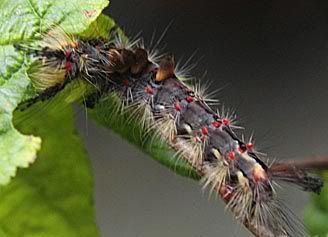
caterpillar id
caterpillar id
This little chap is happily munching on our Corkscrew Hazel tree in the backyard. Can anyone identify him? Also, what is the purpose of the 4 raised lumps on his back? Many thanks.

- Pete Eeles
- Administrator & Stock Contributor

- Posts: 6777
- Joined: Tue Jan 17, 2006 6:10 pm
- Location: Thatcham, Berkshire
- Contact:
Re: caterpillar id
Hi Spooky - looks like a Vapourer moth larva.
Cheers,
- Pete
Cheers,
- Pete
Life Cycles of British & Irish Butterflies: http://www.butterflylifecycles.com
British & Irish Butterflies Rarities: http://www.butterflyrarities.com
British & Irish Butterflies Rarities: http://www.butterflyrarities.com
Re: caterpillar id
Definitely Vapourer and a common species that turns up in many places. Last year at our workplace we had hundreds feeding on a Hazel hedge. Within this hedge is situated a bus shelter type building that the employers have provided for the the smokers. Unfortunately for one of the smokers a caterpillar from inside the roof, fell onto his neck and he came out with a nasty rash. This prompted security to get the hazel razed down to stumps within 10ft either side of the shelter. i took it upon myself to rescue a few and picked up a rash myself in the process, despite handling very carefully.
Despite the 'carnage' there were hundreds of coccoons under the wall eaves behind the hedge. Many were parasitized but also many hatched as was evident by the wingless (sack of eggs) females and the clumps of eggs laid laid on the empty cocoons after mating with the winged day-flying males. Word of warning, neither the caterpillar; coccoon or imago shoud be handled as the irratant larval hairs are passed on at each stage.
Finally, the hedges have grown back and there are a few larvae around but nowhere near the numbers that were there in 2010.
Despite the 'carnage' there were hundreds of coccoons under the wall eaves behind the hedge. Many were parasitized but also many hatched as was evident by the wingless (sack of eggs) females and the clumps of eggs laid laid on the empty cocoons after mating with the winged day-flying males. Word of warning, neither the caterpillar; coccoon or imago shoud be handled as the irratant larval hairs are passed on at each stage.
Finally, the hedges have grown back and there are a few larvae around but nowhere near the numbers that were there in 2010.
